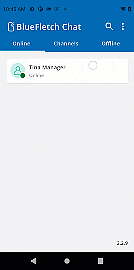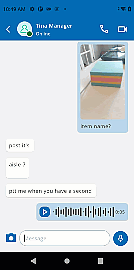Communication is vital to any job, but it’s especially crucial for frontline workers. These people keep the wheels of industry turning, whether on the factory floor, in a warehouse, or out in the field. They need tools that are reliable and tailored to their specific needs. While there are plenty of communication tools out there, many of them don’t quite fit the bill when it comes to supporting frontline workers. That’s where BlueFletch Chat comes in—a tool designed from the ground up with these workers in mind.
The Communication Needs of Frontline Workers
Frontline workers operate in environments that are vastly different from typical office settings. They’re not sitting behind a desk with a computer all day. Instead, they’re on the move, often working in rugged conditions, handling machinery, or dealing with customers face-to-face. Their communication needs are unique, and the tools they use need to reflect that.
For example, imagine a retail store where staff members need to coordinate restocking shelves, assisting customers, and handling cash registers. Or think about a warehouse where workers need to quickly communicate about inventory levels, equipment status, or safety issues. In these scenarios, communication needs to be fast, simple, and focused. There’s no time to scroll through long lists of contacts or navigate complicated menus.
Many of the tools currently available in the market were designed with enterprise office workers in mind. They’re great for sending emails, scheduling meetings, and chatting with colleagues across the organization, but they often fall short when used in a fast-paced, physically demanding environment.
Frontline workers need a communication tool that is straightforward and designed for their specific tasks.
Frontline workers need a communication tool that is straightforward and designed for their specific tasks.
Current Tools and Their Limitations
So, what’s the drawback with the tools that are currently available? Let’s take a look at a few popular options and see where they might fall short for frontline workers.
Corporate Communication Tools (Microsoft Teams, Slack)
Microsoft Teams and Slack are the go-to tools for many corporate environments. They’re designed to connect everyone in an organization, from the CEO to the newest intern. If you need to reach someone, you can usually find them by typing a name or searching for a project group. But here’s the thing—these tools are designed for broad, enterprise-wide communication. They’re perfect if you’re sitting in an office and need to quickly message someone in another department, but they’re not as effective on the frontline.
Do workers in a warehouse really need the ability to chat with someone in marketing or HR? Probably not. They need to communicate with the people around them—their team, their supervisor, and maybe the delivery driver who just pulled up to the dock.
For frontline workers, less is often more. They don’t need all the bells and whistles that come with corporate tools like Teams or Slack. They need something that gets the job done quickly and efficiently, without unnecessary complexity.
Remote Collaboration Tools (Zoom)
Then there’s Zoom, which became a household name during the pandemic. Originally, Zoom was all about video meetings—helping remote teams stay connected face-to-face. Over time, it’s added chat and other communication features, trying to expand its utility beyond just meetings.
However, Zoom wasn’t designed with frontline workers in mind. It’s a tool built for remote office workers who need to collaborate on projects or host virtual meetings. While Zoom has its strengths, it’s not the best fit for someone who needs to quickly send a message to a colleague on the factory floor or communicate with a team in a retail store. It’s simply not tailored for the speed and simplicity that frontline communication demands.
Frontline-Specific Tools (Zebra’s Workforce Connect)
There are tools specifically designed for frontline workers, like Zebra’s Workforce Connect. These tools do a good job of addressing some of the unique challenges that come with frontline work. They’re built to handle the rugged environments and specific tasks that frontline workers deal with every day.
However, these tools can sometimes be overly complex. Setting them up and configuring them can require a lot of technical know-how, and in some cases, they can be tough to use without extensive training. For organizations that need to deploy a communication tool quickly and easily, this complexity can be a significant hurdle.
The Case for a Dedicated Frontline Communication Tool
Given the limitations of these existing tools, it’s clear that there’s a need for something more focused. That’s where a dedicated frontline communication tool like BlueFletch Chat comes into play. But why is it necessary?
 First and foremost, frontline workers need simplicity. They’re not sitting at a desk; they’re out in the field, often dealing with high-pressure situations. They don’t have time to fiddle with complicated software or dig through endless settings. A frontline chat tool needs to be as easy to use as possible—something that workers can pick up and start using immediately, without a steep learning curve.
First and foremost, frontline workers need simplicity. They’re not sitting at a desk; they’re out in the field, often dealing with high-pressure situations. They don’t have time to fiddle with complicated software or dig through endless settings. A frontline chat tool needs to be as easy to use as possible—something that workers can pick up and start using immediately, without a steep learning curve.
Security is another critical factor. Frontline workers often deal with sensitive information, whether it’s customer data in a retail setting or operational details in a warehouse. Any communication tool needs to be secure, with encryption, GDPR compliance, and strong access controls. This isn’t just a nice-to-have; it’s a necessity.
Finally, the tool needs to be tailored to the specific needs of frontline work. This means focusing on the communication patterns that matter most in these environments, such as one-to-one messaging, group chats for specific teams, and walkie-talkie style push-to-talk features. The tool should be designed from the ground up with these use cases in mind, rather than trying to adapt a general-purpose tool to fit.
Key Differences in BlueFletch Chat
What makes BlueFletch Chat the right choice for frontline workers built specifically for frontline workers
- BlueFletch Chat was built specifically for frontline workers
This isn’t an application that’s been retrofitted for frontline use; it’s a tool designed from the ground up for frontline workforce environments. This focus means that every feature, every design decision, was made with their needs in mind.
 The tool is optimized for shared devices. Whether workers are using Android devices from Samsung, Honeywell, or Zebra, BlueFletch Chat is compatible and ready to go. This broad compatibility ensures that organizations can use the tool across different types of devices, without worrying about compatibility issues.
The tool is optimized for shared devices. Whether workers are using Android devices from Samsung, Honeywell, or Zebra, BlueFletch Chat is compatible and ready to go. This broad compatibility ensures that organizations can use the tool across different types of devices, without worrying about compatibility issues. - Ease of deployment
BlueFletch Chat is designed to be quick and easy to set up, without requiring a lot of technical expertise. For organizations that need to get a communication tool up and running quickly, this is a huge advantage. There’s no need to spend weeks or months configuring the system or training staff; you can deploy it and start using it right away. - Avoids unnecessary complexity
For example, many communication tools include VoIP (Voice over IP) features, which allow users to make voice calls over the Internet. While this can be useful in some settings, it’s often overkill for frontline workers. VoIP can be tricky to set up, and in many cases, it’s simply not needed. BlueFletch Chat skips the VoIP feature, focusing instead on the communication methods that are most important for frontline workers, like text messaging and push-to-talk.
It’s tailored to the way frontline workers communicate, allowing for the creation of specific communication channels and roles. This ensures that messages get to the right people without unnecessary noise, helping to keep communication focused and relevant, which is crucial in a busy frontline environment.
While there are plenty of communication tools out there, most of them weren’t designed with frontline workflow in mind. They’re either too complex, too broad, or simply not suited to the fast-paced, physically demanding environments where frontline workers operate.
BlueFletch Chat was built to fill this gap. It’s a simple, secure, and focused communication tool that meets the unique needs of frontline workers. By addressing the limitations of existing tools and providing a solution that’s tailored to frontline environments, BlueFletch Chat helps to ensure that workers can communicate effectively and efficiently, no matter where they are or what they’re doing.

 The tool is optimized for shared devices. Whether workers are using Android devices from Samsung, Honeywell, or Zebra, BlueFletch Chat is compatible and ready to go. This broad compatibility ensures that organizations can use the tool across different types of devices, without worrying about compatibility issues.
The tool is optimized for shared devices. Whether workers are using Android devices from Samsung, Honeywell, or Zebra, BlueFletch Chat is compatible and ready to go. This broad compatibility ensures that organizations can use the tool across different types of devices, without worrying about compatibility issues.